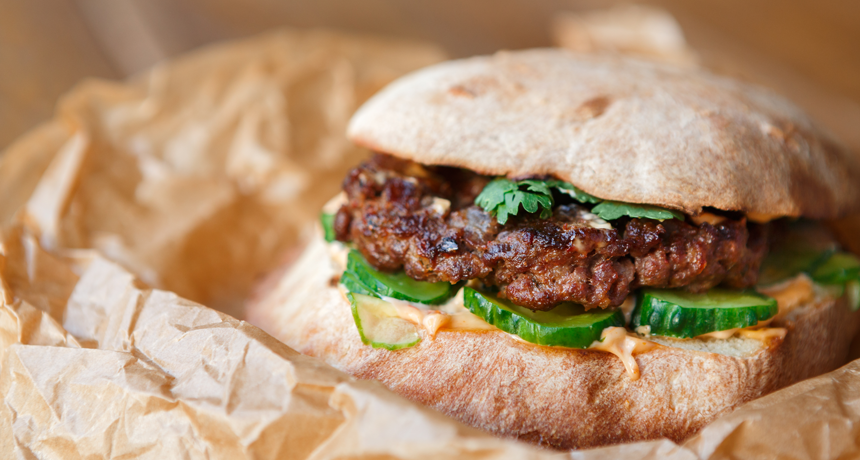Did your burger come with a side of non-degrading pollutants?
Non-stick chemicals that might be harmful are showing up in fast-food packaging

Some fast-food wrappers contain PFCs, potentially harmful chemicals that won’t break down in the environment — or you.
Milkos/iStockphoto
One attraction of fast foods is that they’re, well, convenient. They’re ready minutes after you hit the burger joint, taco stand or fried-chicken emporium. But another aspect of their convenience is less obvious: The paper or cardboard in which they’re wrapped tends to resist absorbing liquids, including fat. So the oils used to turn chicken wings and French fries golden brown don’t bleed through onto your hands or lap. What makes this possible, in many cases, is a class of potentially toxic, long-lived chemicals. And these may live on to pollute you or the environment.
That’s the conclusion of a new study.
Here’s why they’re worrisome, says Laurel Schaider: “Some of these chemicals are thought to cause cancer, harm our immune systems, or even change the way our bodies develop as small children.” Schaider is an environmental chemist at the Silent Spring Institute in Newton, Mass. Such scientists study how chemicals can enter and move through the environment.
The chemicals that make these wrappers oil-resistant are called perfluorinated (Per-FLOOR-ih-nay-ted) compounds, or PFCs. They take their name from the fact that they’re loaded with fluorine atoms. Manufacturers have for decades been churning out huge amounts of PFCs.
Because PFCs don’t degrade, these chemicals have been accumulating throughout the environment. Scientists have found traces of them on all seven continents and in the oceans. These chemicals are not supposed to be eaten by animals or us. Yet studies have been finding them in fish and birds, polar bears and people. Indeed, at least trace amounts taint the blood of most Americans.
One way PFCs might enter the body is through food. They can rub off food wrappers and end up on someone’s fingers — or in the food itself. So for its new study, her team looked for PFCs in food packaging.
And they found evidence of plenty.
The researchers went to 27 fast food restaurants in 5 states. They collected more than 400 pieces of food packaging made from paper or cardboard. These included paper cups, wrappers for burgers and fries, pizza boxes and pastry bags. There are hundreds of different PFCs. The researchers did not identify which particular ones had been in their samples. Instead they measured the total amount of fluorine in each sample. Its presence indicates that a product likely contains PFCs, explains Schaider.
Almost half of the paper used to wrap foods like burgers or cookies contained fluorine, they found. About one in every five cardboard products also contained fluorine. Called paperboard, this thin cardboard is the somewhat stiff material used to hold foods such as fries.
Schaider’s team reported its findings March 14 in Environmental Science & Technology Letters.
Some PFCs risk altering the normal development of a fetus or a child. Those changes may include altering human growth, learning and behavior. Some PFCs can harm reproduction. At least a few PFCs can mimic — or interfere with — the body’s natural hormones. PFCs not only can impair the immune system, but also have been linked with boosting cholesterol, which is a risk factor for heart disease. Some PFCs even appear to boost cancer risks. This long list of potential health issues comes from the Agency for Toxic Substances and Disease Registry, part of the U.S. government.
Indestructible chemistry
PFCs start with linked chains of carbon atoms. This serves as the backbone of each molecule. To this, manufacturers add fluorine atoms. They bond to each carbon in the chain.
The carbon-fluorine bond is one of the strongest known. That toughness imparts special properties. PFCs don’t absorb water or oily fats. They don’t degrade with heat. And they resist breaking down in the environment. Some may survive, unchanged, for thousands of years.
Story continues below image

These properties have made the chemicals attractive for a host of uses. They make some pots and pans nonstick. They turn coats and camping tents largely waterproof. They help carpets and upholstery resist stains. And they help keep the wrap on your burger and French fries from getting oily. It even keeps microwave-popcorn bags from releasing the oil used to help that corn pop.
“The downside is that we’ve manipulated the chemistry so much that nature can’t break them down,” says Terry Collins. He directs the Institute for Green Science at Carnegie Mellon University in Pittsburgh, Pa. As a “green chemist,” he looks for safer alternatives to chemicals that may be harmful, such as PFCs.
When we throw away a cookie pouch or burger wrapper, it goes to a landfill. As the wrapper breaks down over time, any inks or other potentially toxic chemicals in it can leach into water, soil and the air. From there, these chemicals can enter the food web and get passed between organisms as they eat each other. Since the compounds don’t break down, each predator’s body will collect the PFCs that had been in its prey. The more they eat, the higher the levels of these chemicals that can end up in an animal’s body.
Collins says we need to start thinking more seriously about what goes into the products we use everyday. It may be nice to wrap up your meal in something that neither food nor water will penetrate. Yet doing so may risk adding indestructible and potentially harmful chemicals into the environment. People need to ask, he concludes: Is that convenience worth the risk?







